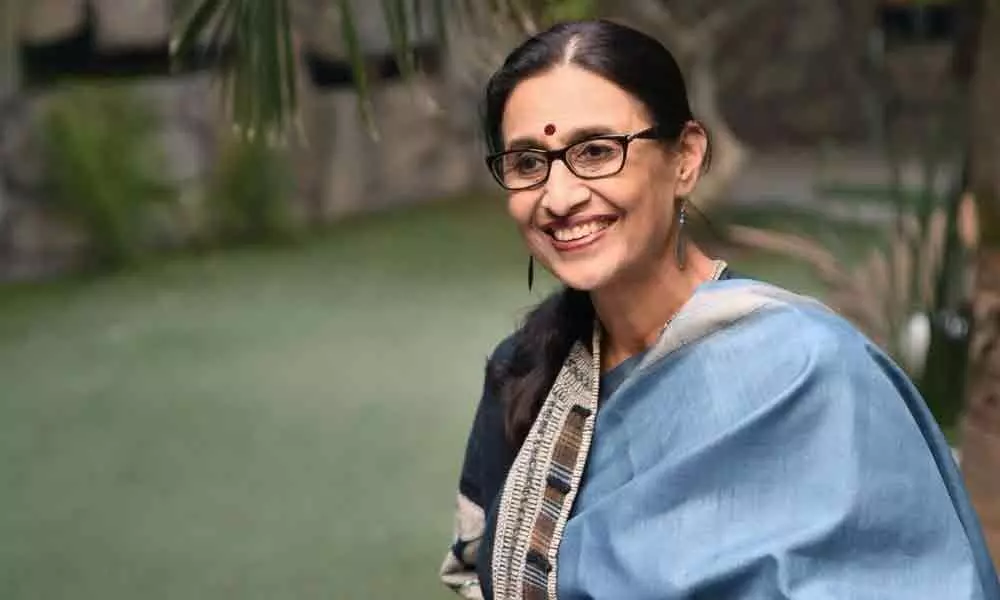Live
- State government to Supreme Court: New guidelines on how to apply anti-gangster law in UP
- CM Chandrababu to unveil Vision 2047 document today in Vijayawada, traffic restrictions imposed
- State-level LIMES-2k24 inaugurated
- UP to establish ‘Har Ghar Jal’ village at Mahakumbh 2025
- NDA needs support of 361 LS MPs: Cabinet gives nod to bill for 'one nation one election'
- Kejriwal woos women voters with Rs 2100
- Transforming leftovers: 2 innovative recipe ideas
- MLA seeks shipbuilding industry at Chinnaganjam
- Papon marks 20 years in music: A journey of soulful versatility
- Jasleen Royal to collaborate with Coldplay at ‘Music of the Spheres World Tour’
Just In
Crafting sustainable art & culture stories


Anjana’s journey over the past 40 years has been interspersed in a myriad of fields including culture, music, crafts and theatre.
Anjana's journey over the past 40 years has been interspersed in a myriad of fields including culture, music, crafts and theatre. Folk traditions took much of her attention and she unearthed a great potential in the economics of craft.
Apart from creating varied cultural festivals, she furthered her interests through commercial craft exhibitions, study tours to historical or craft sites. To her, the 'business of craft' has offered an exciting platform, unfortunately often perceived as a mere souvenir.
Recently Anjana Somany, Founder of Mango Tree, organised a conference 'Business of Handcrafted Sustainable Luxury: Guiding Future of the Indian Handicraft Sector', in collaboration with Indian School of Business (ISB) as the Knowledge Partner for the event held at its Hyderabad Campus.
The primary goal of organising this conference was to initiate a discussion about the positioning of handicrafts sector as sustainable luxury and to discuss the shift in business models and marketing strategies within the sector.
Sharing her journey, she says "I am passionate about handicraft like any Indian, but the journey began when I came to Hyderabad, where I joined crafts of Andhra Pradesh and from the beginning, I was one of the members of the founding committee, this was my changing ground, I was groomed and trained by the people who started it."
The craft field has been a very important part of her journey. On this, she says "Mango Tree is involved in various activities like we study different workshops, we work with different exhibitions, then we have workshop segments with crafts.
So, I started it under one tree, my activities, my love for research, everything I did, I connected it to the living traditions which are the craft traditions that I explored. So, when I went to overseas for exhibitions and things, the topic was always the historical aspects of any practice and then connecting it to the living traditions.
The cultural narratives still have the tapti tradition continuing in India, then we have the Ajanta caves and the paintings, in India we don't have stories through pictures instead we have oral tradition and many cultures continue to choose oral tradition to tell stories. They would say it either in the cultural beliefs or in paintings or they could be stitched or they can be embedded."
Today the business of craft is the compelling matter and is being positioned in the sustainable luxury segment both nationally and internationally. India, with its rich and varied craft tradition, must regain its position as the major player.
She says "People used to tell stories of the society, of religion it could be religious, or it could be social issues. Like you talk about the preceding, but then you also have the scroll which talks about the narratives of the community which celebrates the hero who saves, who is real, who exists, who is an icon of the community, that's what they're doing.
Some of them talk about local heroes, some about geographical location and about daily life, Madhugani artists talk about about the cosmos. so, it is always connected to nature. Nature, the existence of man and social issues."
She further says "Actually the business has to be sustainable because end of the day craftsman needs to have his stuff sold otherwise he'll not remain in that practice and for that, you have to understand what all you have to embrace.
In India craft practices and skills have held centre stage both within the country and across the shores. Since antiquity, India was recognised for its advanced skills across mediums of that were handmade. The artisan was the artist who created beauty within their homes and in the everyday utilitarian items which were reflected in the simple forms and the adornment on them.
The advanced knowledge pool of the use of colours, weaving and patterning, crafting personal adornment or propagating personal stories and those of the cosmos, made India the leader in the global market. And the largest contributor to the exchequer was those unmatched skills that were positioned in the luxury segment.

© 2024 Hyderabad Media House Limited/The Hans India. All rights reserved. Powered by hocalwire.com






